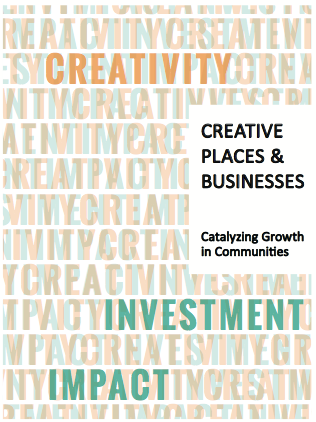Research

Download Research Report PDF
Download Executive Summary PDF
Overview
Over the past 20 years, impact investing has grown as a field. Impact investment now responds to targeted investor interest and substantiated opportunities with dedicated investment products. Just as investors who want to elevate women and girls can now adopt a gender lens, investors who care about arts and creativity need a way to direct their impact capital.
This report looks at investable opportunities in the Creative Economy with the potential to stabilize threatened communities and benefit regions looking to attract and develop quality jobs, and suggests that impact investment can be used to shape a Creative Economy that is inclusive, equitable and sustainable.
Opportunity and Impact
The Creative Economy in the U.S. is more than $920 billion or 4.3% of U.S. GDP. But currently, 0% of impact investment is in the arts & culture sector.
This is largely because impact investment in the Creative Economy – especially those happening as part of community development – have been flying under the radar. While community development finance institutions have been deploying capital into Creative Places and Businesses for decades, these investments have been categorized as affordable housing, community facilities or small businesses – with no attention to their creative characteristics.
But the opportunity to garner a financial return and create social impact through art, culture, design and innovation has never been stronger. Creative placemaking has become a core component of comprehensive community development. Artists and designers are founders of some of the leading companies of the internet age, and the cross-over between sustainability and the Creative Economy is demonstrated by successful B Corporations like Kickstarter and Etsy. In fact, 10% of U.S. B Corporations are in creative industries, generating social impact and financial returns.
According to impact investing wealth advisors like Veris Wealth Partners, Tideline, Sonen Capital, Cambridge Associates, JP Morgan, UBS and others, their clients have been asking for opportunities to invest in arts, culture and creativity. Now, there is a real opportunity to connect impact investing with the Creative Economy.
Key Findings
Creative Places and Businesses are ready for impact investing. Demand for impact capital will be strong among Creative Places and Businesses over the next five years throughout the U.S. This research identified 26 projects in 14 states with total project costs of $1.543 billion seeking impact investment capital for the period of 2017-2022. While this pipeline is illustrative, it is far from comprehensive.
Impact investors are seeking ways to deploy capital for creativity. Institutions that value the arts, storytelling, creativity, art lovers, art collectors, and artists themselves are looking for opportunities to align their capital with their priorities. The leading impact investing wealth advisors confirm that their clients are asking for opportunities to invest in the arts and the Creative Economy.
There are addressable barriers. The most immediate barrier is that Creative Places and Businesses must be recognized as a segment so that investors, intermediaries and project leaders can find one another and cooperate more easily. This will enable impact capital to truly meet effective demand. In addition, the ecosystem connecting impact investors to Creative Places and Businesses with sustainable business models must be strengthened. While the pieces are all in place – interested investors, vehicles for raising impact investment capital, vehicles for deploying impact investment capital, and investable deals – some effort is needed to intentionally connect these dots.
Implications
This moment of early 2017 is a crucial time for underserved communities across the United States. As public spending cuts loom on the horizon, impact capital has the potential to fill the void in support of communities and the creative solutions they deserve.
As more institutions move to mission-related investing and more individuals adopt impact investing, arts and culture could lose out entirely unless targeted investment options are developed. As a result, it is critical to bring a creativity lens now.
